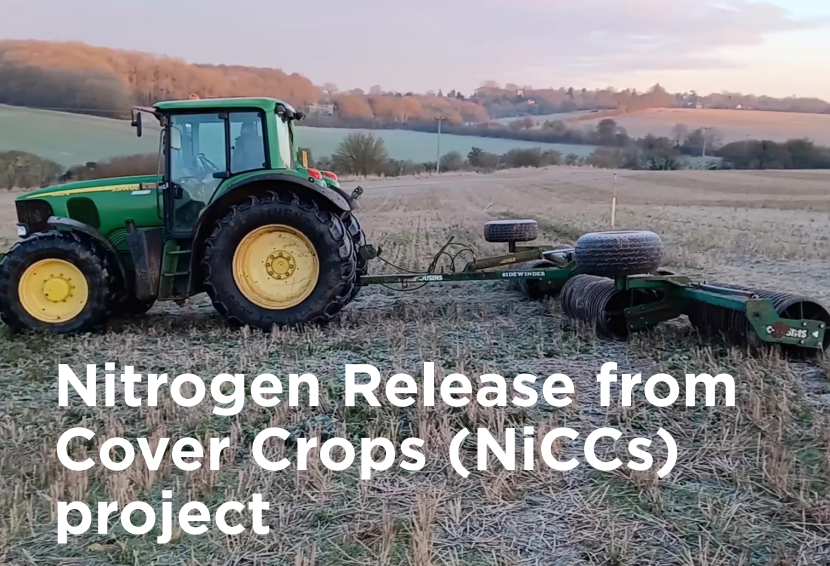Background & rationale
The informed management of cover crops is key to the delivery of important UK Government policies including the 25-year Environment Plan and improvements in ground and surface waters. Cover crops have been included in the ‘Sustainable Farming Incentive’ 2023 actions for soils (‘SAM 2: Multi-species winter cover’) which is one of the environmental schemes being introduced under the Agricultural Transition Plan post-Brexit. Whilst the benefits of cover crops for erosion control and reduced overwinter nitrate leaching losses are well established, the legacy effect for subsequent crops in the rotation is unclear. Of particular relevance is the timing of nitrogen release from cover crop residues and how this influences the nitrogen fertiliser requirement of the following cash crop and subsequent nitrate leaching losses.
The use of cover crops in conventional farming systems has rapidly increased (Storr et al., 2019 [1]), but guidance for farmers is often very general or inconsistent and not necessarily based on UK experiences (AHDB Research Review No. 90). A recent survey of UK farmers on the use highlighted the uncertainty of the effects of cover crops on crop available nutrient supply (Storr et al., 2019). Furthermore over 80% of the farmers were destroying cover crops with herbicide. Given the uncertainty over the future of glyphosate use in the UK post 2025, and the movement to ‘regenerative’ farming with the associated increase in minimum/zero tillage, more information is required to help farmers develop alternative destruction methods that are economically viable and do not compromise the establishment and management of the following cash crops. Further information is also required to understand the impact of cover crop species and destruction method on nitrogen cycling to more accurately quantify the timing and amount of nitrogen released.
Methodology
This work has built on the research undertaken as part of the AHDB funded Maxi-Cover crop project [2] by focussing on the effect that cover crop species mix and destruction method have on nitrogen release i.e. how much and when. The information will be used to underpin advice on the appropriate management of cover crops in terms of the crop available nitrogen supply and long-term impact on nitrate leaching.
Measurements were carried out on replicated field plot experiments (6 treatments replicated 3 times = 18 plots) over two cropping seasons (2021-2023), on two commercial farms: one in Hertfordshire and one in West Sussex. The 3 covers tested were:
- No cover: weedy stubble
- Mix 1: Phacelia (20%) & Oil Radish (80%) @ 15 kg/ha; with the oil radish (‘triangle’) being a certified club root resistant variety
- Mix 2: Japanese oats (45%), Buckwheat (45%) & Phacelia (10%) @ 10 kg/ha
Covers were destroyed by two methods: mechanically by either rolling on a frost (Hertfordshire: no tillage) or chopping and incorporating (West Sussex: reduced tillage) and chemically (glyphosate at both sites).
The work was funded by Affinity Water and Portsmouth Water, with the seed mixes kindly supplied by RAGT seeds. This was a collaborative project, working very closely with our host farmers, who conducted all farm operations with their own kit/machinery, ensuring the results are representative of commercial practice.
Crop destruction techniques:
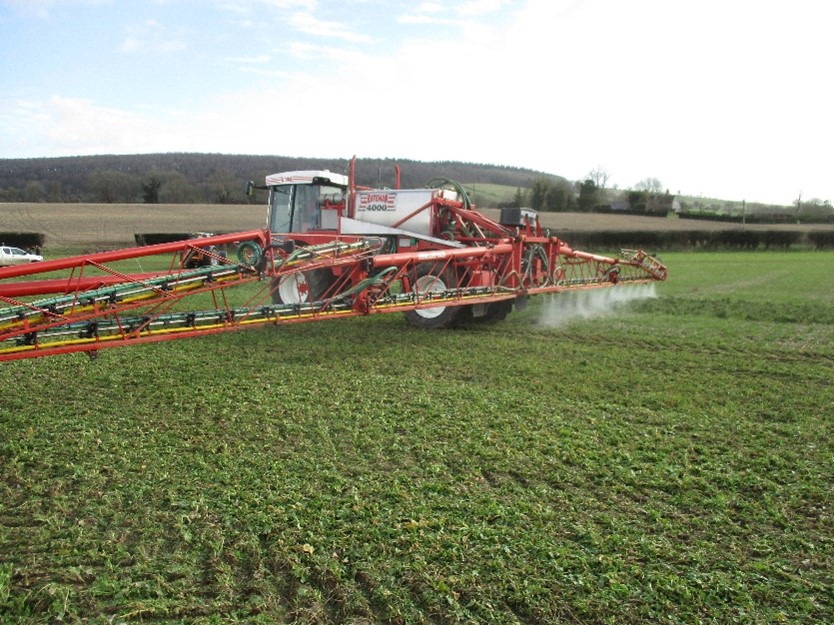
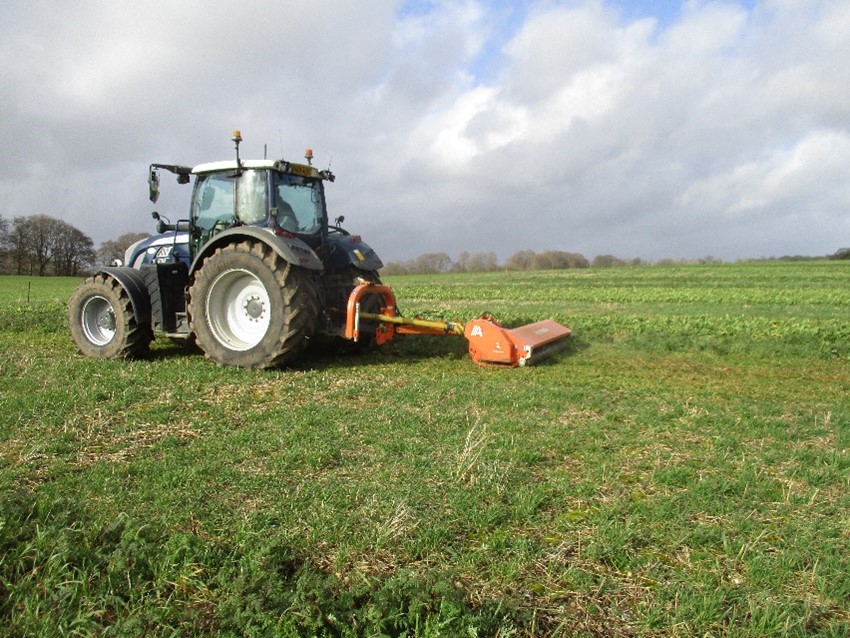
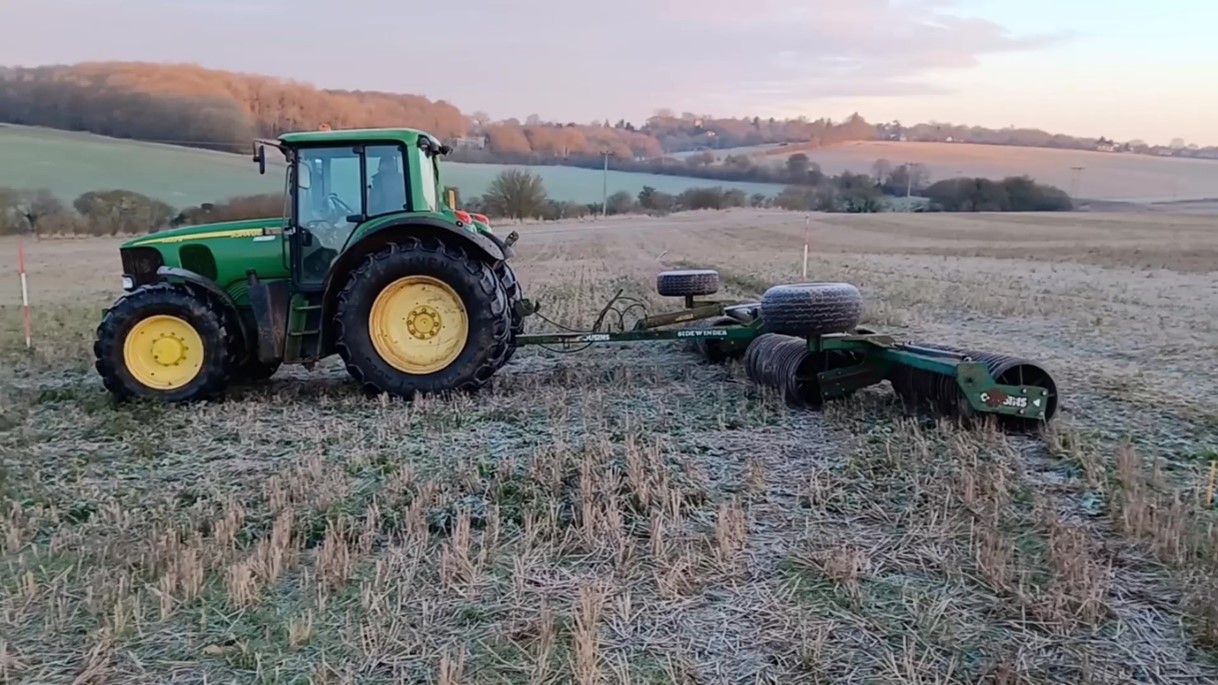
Key findings:
- There was clear evidence that cover crops can reduce nitrate leaching losses by up to 90% compared to weedy stubble.

- Cover crops increased spring soil nitrogen (N) supply by up to c.35 kg N/ha compared to the weedy stubble, but this depended on how well the covers had established (size of the above ground cover crop biomass) and the species mix (ability to scavenge N).
- Cover crops released more N following destruction and decomposition in the soil (mineralisation) than from the weedy stubble control.
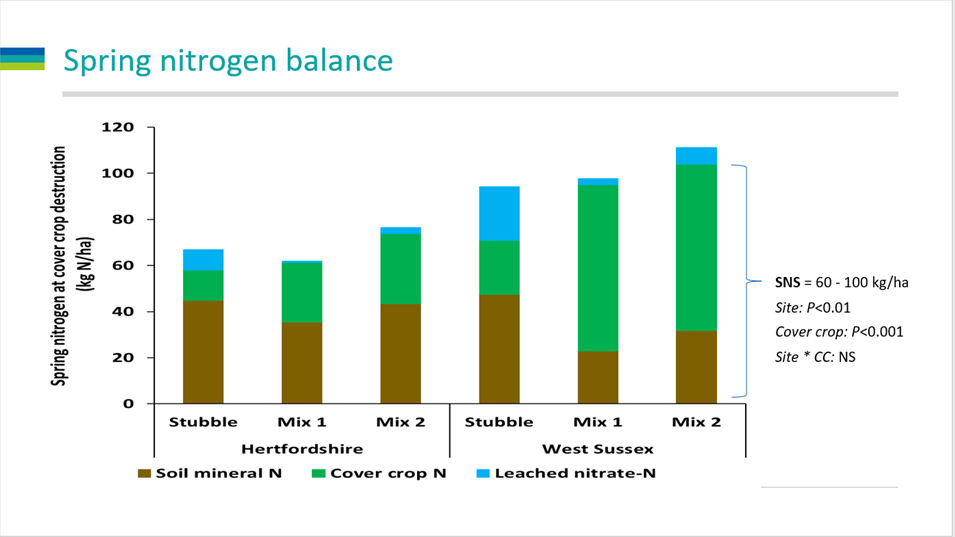
- Cover destruction using glyphosate increased topsoil mineral N compared to mechanical destruction, regardless of the method used i.e. rolling on a frost or chopping. The greater and earlier mineral N availability following cover destruction using glyphosate is likely to have benefited spring cereal establishment and subsequent crop performance.

- Chopping as a destruction technique did not destroy oil radish (& its below ground tap root) where it was used in a cover crop mix. Oil radish re-growth required a robust post emergence herbicide for control in the subsequent spring cash crop.

- There was a reduction in the specific weight of spring oats grain to below that typically accepted by millers (50 kg/hl) where winter cover had been destroyed by rolling on a frost. The spring oat specific weight exceeded milling requirements when glyphosate was used. This may reflect the earlier mineralisation of N in the covers and subsequent N availability to the following spring oat crop where glyphosate had been used to destroy winter cover.

- Spring cereal yield, grain N offtake and total crop N uptake were consistently reduced where the covers had been destroyed mechanically (rolling on a frost or chopping) than by using glyphosate. Cover crops increased the spring cereal yield by 0.2-1.0 t/ha compared with the weedy stubble control.
- There was a mean 0.7 t/ha spring oat yield reduction from rolling on a frost, and up to a 1.0 t/ha spring barley yield penalty following chopping.

- Autumn soil mineral N content measured after harvest of the spring cash crops was 20-30 kg N/ha higher on the weedy stubble control, reflecting the poorer performance (and N utilisation) of the spring cereals where no cover crops were grown.
- There was no legacy effect of cover type or destruction technique on either the nitrate leaching losses measured over winter following spring cereal harvest or on the subsequent spring soil N supply. The crops grown in the legacy year (i.e. a cover crop and oilseed rape) had an autumn N requirement. If an autumn sown crop which did not have an autumn N requirement (e.g. winter cereal) had been used, there would have been an increased risk of losing autumn soil mineral N via over winter nitrate leaching.
- This study showed that it was more cost-effective to not grow a cover crop and destroy any weeds chemically, although the margins over and above growing a cover crop (with chemical destruction) were small and didn’t take account of any environmental incentive a farmer might receive for growing a cover crop (e.g. SFI). There is also the potential to reduce fertiliser N inputs following cover crops, although further work is required to understand the level of reduction possible more fully.
Overall, this study has clearly shown the benefit of growing a cover crop to reduce nitrate leaching losses over winter and increase soil nitrogen supply to the following spring cash crop. Chemical destruction, using glyphosate, was far more effective than mechanical destruction (rolling on a frost or chopping and incorporating) at reducing the weed-burden and also resulted in a more rapid release of nitrogen which can be important for early development of the cash crop and subsequent yield and quality. The study has also shown the importance of incentive schemes to support cover crop use so ‘harder to monetise’ benefits such as improved water quality, soil health and biodiversity can be realised.
[1] Storr, T., Simmons, R.W. & Hannam, J.A. 2019. A UK survey of the use and management of cover crops. Annals of Applied Biology 174: 179-189.
[2] Bhogal, A., White, C. & Morris N. (2020) Maximising the benefits from cover crops through species selection and crop management. AHDB Report PR620 https://ahdb.org.uk/maximising-the-benefits-from-cover-crops-through-species-selection-and-crop-management-maxi-cover-crop

